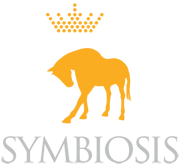The horse’s natural way of going (when he is not ridden) is to have more weight on the forehand than on the hindquarters, the center of gravity is right behind the scapula and a few inches towards the elbow. The body weight distribution is, for example, if we half the horse in two, is 60% of his weight is on the forehand and the rest, a 40% is on his hinds.
Having said this it is clear that the horse has not got the weight spread evenly over his four legs.
He goes around the pasture freewheeling, that means bearing most of the weight on the front, strolling calmly and eating along.
The rear of the horse is the engine, that means the hindquarters are made to propel and push the horse forward, and the forehand (being narrower and less heavy) is to turn and break. The head and neck act like a lever, shifting the weight backwards and forward as needed for the horse. All horses can shift their weight easily when unmounted. This mechanism has been of great help when fleeing from danger, and horses have survived thanks to it.

Why i am telling you all this?? well this is very important when trying to understand the principles of riding and to train alongside with your horse.
When we sit on a horse we upset its natural balance and without realising it, we force them to hollow their back, this is a reflex mechanism, on an untrained horse back the muscles flex when weight is put on them.
To upset the least the horse’s balance the classical seat developed (amongst other seats), and with this, the idea of engagement and collection.
In a nutshell the idea is to shift the horse’s center of gravity so it can match ours as well as spreading the weight evenly over the four legs of the horse, and over time and lots of training, shifting more weight onto the rear of the horse so the horse can :
- Carry us and move around with the least annoyances.
- Avoid injuries on the front of the legs due the overload of our weight on top of its own weight.
- Avoid injuries on the back.
- Make the ride as comfortable and fun for the horse as it is for us.
- Be able to perform all the movements the horse performs in the wild with ease and lightness.
The green dot is the progression of the center of gravity of the horse thorough training, from being on the forehand and moving back towards the engine of the horse.
For all this to be achieved, we need time, knowledge and lots of patience.
Being a rider is not an easy task, a broad knowledge and awareness on where you are spatially every second is paramount, the horse will respond to the slightest change or manoeuvre. Hundreds of hours in the saddle are needed alongside with the right coaching.
The horses need time to learn to rebalance themselves with our weight on top, more so if these have just been started under the saddle or are youngsters, and to build up the necessary muscles to be able to do it without pain and with pleasure. We as riders and trainers should always keep this in mind and ride and train accordingly.




